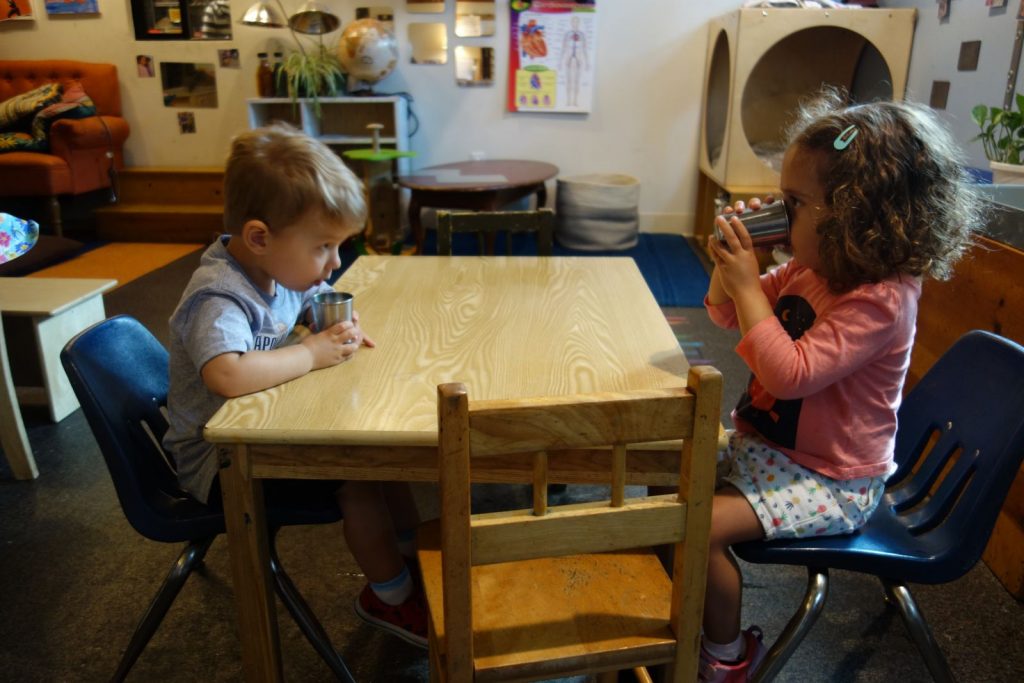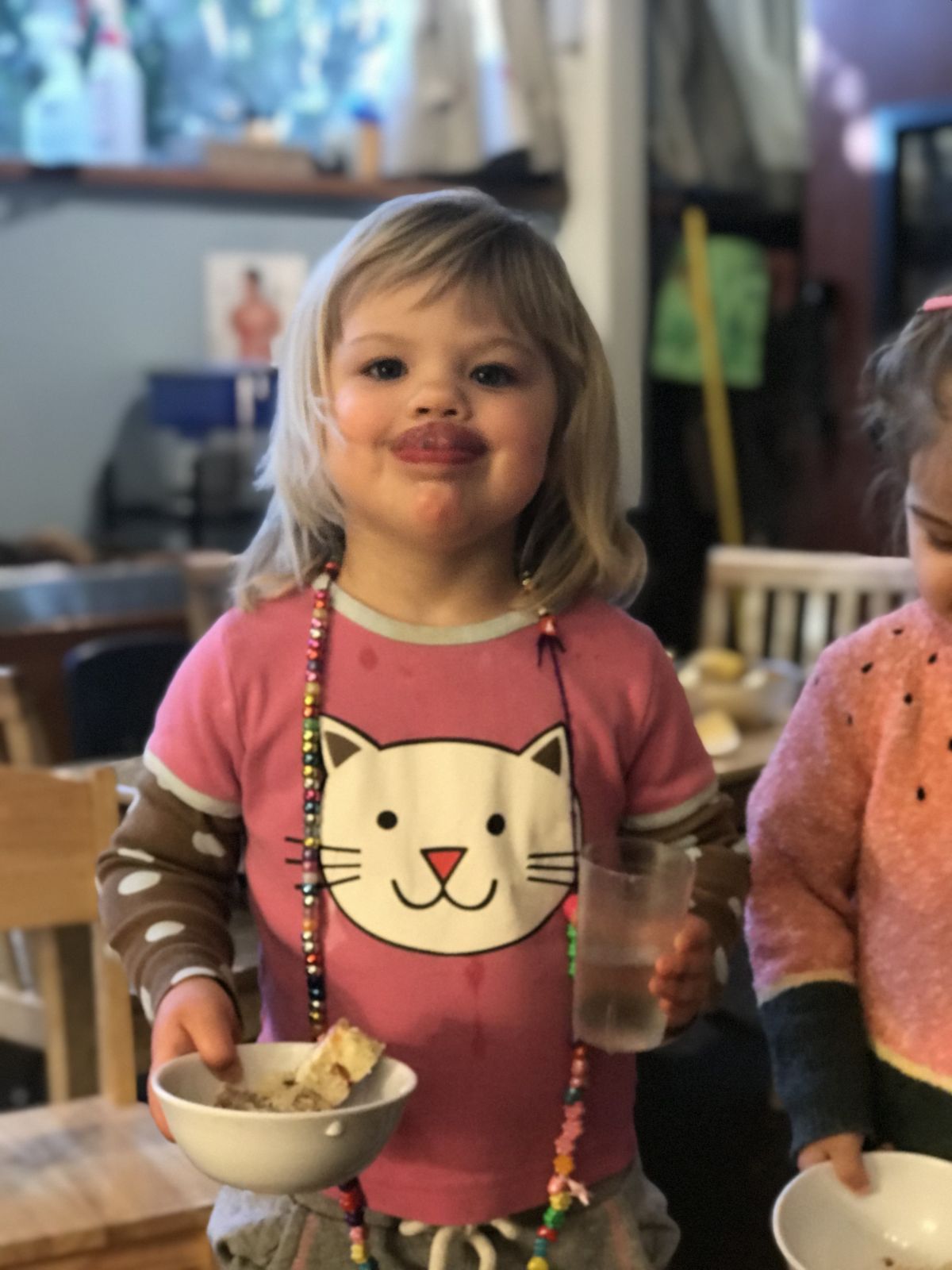
Food for Thought
[et_pb_section fb_built=”1″ _builder_version=”3.22″][et_pb_row _builder_version=”3.25″ background_size=”initial” background_position=”top_left” background_repeat=”repeat”][et_pb_column type=”4_4″ _builder_version=”3.25″ custom_padding=”|||” custom_padding__hover=”|||”][et_pb_text _builder_version=”4.0.2″ hover_enabled=”0″]
How does food create meaningful interactions?
I eat lunch and snack with the children in my class of 3-5 year olds every day, and have been thinking a lot about our relationship with food, as well as the connection between food and our relationships with each other. I’ve been tracing a parallel between being fully present while connecting with another person, and being more mindful of food as more than simply a means to survive Almost all biological organisms rely on food for sustenance, consuming nutrients, oxygen, and sunlight from the environment to grow. Yes, we eat food to survive, but this relationship can go beyond just survival for social beings. We are influenced by our personal experiences as well as the cultures we are connected to; inviting people for dinner, sharing food with them, and giving back to the community. These experiences help us understand how we interact with and honor our food.
How am I honoring the food I eat?
I’ve realized that sometimes I am not fully present when I am eating. This eating process becomes secondary, low in the rank of priorities in my day. If I am not fully present, then I’m missing out on the very important quality that food provides us – the ability to make new memories and reconnect with older ones. We can take our time during meals to share our thoughts and stories, without distraction.
Slowing down and allowing time throughout the eating process can become a priority in our relationship with food. From preparing the ingredients, to eating the food, to digesting a meal, if we take more time with each step of this process, we can better understand and connect with our memories and internal dialogues.
How does my interaction with food impact digestion?
When thinking about digestion, I believe that this process happens on more levels than just the body’s ability to break down food particles. When we slow down and open ourselves up to experiences, we are savoring the moment. By slowing down the eating process, intentionally chewing and swallowing our food, we are allowing ourselves to have conversations about feelings and experiences. In that moment, we find ourselves feeling the feelings that come up, observing them, getting to know them. When we are talking about feelings and experiences, perhaps we are digesting them at the same time that we are digesting our food.

So what does this concept of digestion mean for young children’s experiences?
With these thoughts in mind, I’ve been considering ways to give children opportunities to honor the food they eat, and make more connections between food and relationships. One strategy I’ve tried is to encourage them create their own stories through their food. During lunch time, children often notice whether what they have brought for lunch matches another friend’s lunch:
Simon: I got strawberries today! Hey Claudia, you have strawberries too. We are going to the strawberry party!
Claudia: Yes! And you have dough just like me (sandwiches), so we are going to the dough party and to the strawberry party.
Conversations like this one happen often, and after going around the table noticing what they each have for lunch, the children usually ask me to drive them to the “dough/strawberry party” or whatever food seems to be the one that they all have in common. If no similarities are found among their foods, they say they are going to the “lunch party.”
Another way to make space for meaningful interactions with food is to invite children to prepare food together, which sometimes lead to exploration of the cause and effect of their own choices. Thinking creatively to solve a problem and stepping into a place of accountability is hard work, especially when thinking about other’s needs. Recently, the children in my class were so interested in a book called “Pizza Day” that they asked us to have a pizza day in our classroom. The most popular choice of topping was pepperoni, and I asked children if they wanted pepperoni on their pizza or not. Presented with that choice, they were quick to share their preferences. We needed to make both kinds of pizzas – with and without pepperoni. As we prepared them, some children became confused about why they were making pepperoni pizza if they had indicated that they wanted cheese pizza, and vice versa. We found that we had to continually remind the children that the pizza they were making was not just for them, but for everyone.
 We popped our pizza trays into the oven and excitedly waited for them to be ready. As soon as the pizza was ready, and the slices were in front of each child according to their preference, a couple of children changed their minds about not having pepperoni, deciding they really wanted this topping to be part of their pizza. Now what?
We popped our pizza trays into the oven and excitedly waited for them to be ready. As soon as the pizza was ready, and the slices were in front of each child according to their preference, a couple of children changed their minds about not having pepperoni, deciding they really wanted this topping to be part of their pizza. Now what?
Without prompting the children to talk about solutions, we watched as the children that didn’t had originally requested pepperoni initiated a discussion highlighting a few ideas. They reminded those children who had had a change of heart that everyone’s choices were previously made, and they all needed to stick with their decisions. They emphasized that even if they didn’t have pepperoni this time, other opportunities for pepperoni pizza would come. To be honest, at the beginning I was hoping that some children would share their pepperonis or offer a different solution for this pizza dilemma, but instead, I was happily surprised that children felt very strongly that “you have to stick with the choices you make, you will be ok.” What was more stunning for me it was that these comments made an impact for those couple of children: they no longer wanted to add pepperonis to their pizzas, and didn’t seem to be upset about it anymore, stating “Well, next time I can have some. It’s ok.”
When thinking about this fundamental relationship we can have with our food, I reflect on the myriad of ways this relationship is influenced by our culture and personal experiences, informing the ways we enjoy and respect the food we eat and the communities we are a part of.
How do you honor your own food? What value does food have in your family and cultures? How do you support the children you care for to build relationship with their food, and with each other?
![]()
Paty is an educator with 2- to 3-year-olds at Hilltop Children’s Center, where she has worked since 2017.
Learning in relationship is one of the core values Hilltop aims to bring to life. Through support and organizational integrity, Hilltop is able to support educators and develop structures that enhance reflection and uphold program values. Interested in exploring such models? Join us for either a Study Day or a multi-day visit to Hilltop to see child-centered and reflective practice in action. Talk directly with program leaders and educators from Hilltop classrooms, witness real-life examples of successful long-term project work with young children and closely study and discuss effective structures for values-based Administrative Practices. For more info, email Mike at institute@hilltopcc.org or visit our website at https://hilltopcc.com/institute/inquiry-visit/
[/et_pb_text][/et_pb_column][/et_pb_row][/et_pb_section][et_pb_section fb_built=”1″ admin_label=”section” _builder_version=”3.22″][et_pb_row admin_label=”row” _builder_version=”3.25″ background_size=”initial” background_position=”top_left” background_repeat=”repeat”][et_pb_column type=”4_4″ _builder_version=”3.25″ custom_padding=”|||” custom_padding__hover=”|||”][/et_pb_column][/et_pb_row][et_pb_row _builder_version=”3.25″ background_size=”initial” background_position=”top_left” background_repeat=”repeat”][et_pb_column type=”4_4″ _builder_version=”3.25″ custom_padding=”|||” custom_padding__hover=”|||”][/et_pb_column][/et_pb_row][/et_pb_section][et_pb_section fb_built=”1″ _builder_version=”3.22″][et_pb_row _builder_version=”3.25″ background_size=”initial” background_position=”top_left” background_repeat=”repeat”][/et_pb_row][/et_pb_section][et_pb_section fb_built=”1″ _builder_version=”3.22″][et_pb_row _builder_version=”3.25″ background_size=”initial” background_position=”top_left” background_repeat=”repeat”][/et_pb_row][/et_pb_section]